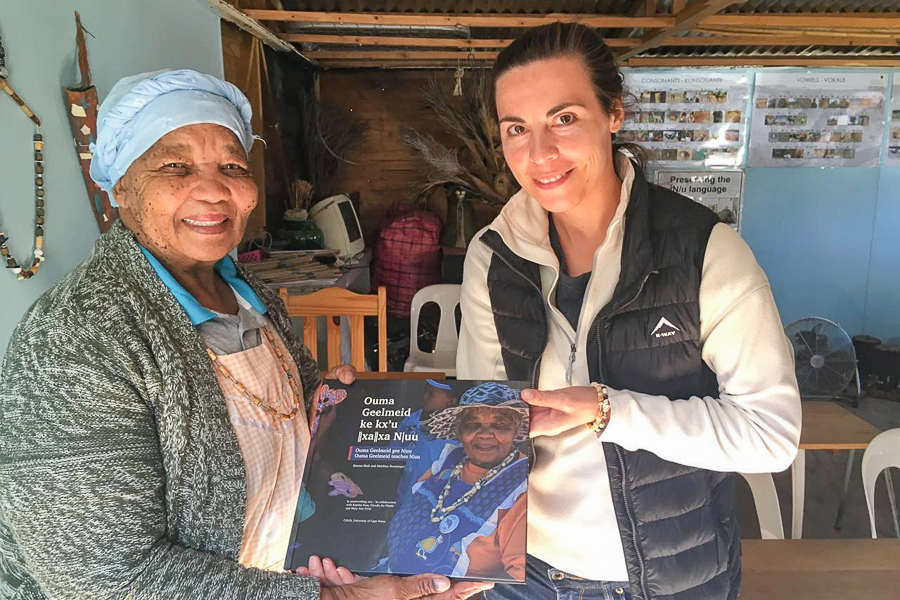
Brenna Henn researches African genetics, human origins
The bookshelves taking up one wall of Brenna Henn’s office are mostly empty. She’s still moving in, having only arrived at the start of this year as a new associate professor in the anthropology department. Henn’s research focuses on evolutionary and population genetics, particularly in southern Africa.
“We study evolutionary and population genetics in under-represented human populations, mainly from southern Africa,” said Meng Lin, a postdoctoral researcher in Henn’s lab, in an email interview. “We pair genomic data and complex phenotypes collected from the communities, and use computational approaches to address our questions.”
Henn became interested in African genetics as an undergraduate and remained focused on that field throughout her graduate and postgraduate studies. As a Ph.D. student, she went to eastern Africa to collect data on a local KhoeSan-speaking population. KhoeSan languages include speech sounds called clicks that occur as consonants. She followed the click language down to southern Africa, where a native population called the KhoeSan live, and collected genetic data to compare to the samples collected in eastern Africa.
“When I did that, I found that the southern African populations had incredible amounts of genetic diversity,” Henn said. “Much more so than the east African populations, and we ended up modeling that, if there was a single location for a human origin for the modern human populations, like the ancestral population for everybody alive today, then actually southern Africa’s more likely to be the location than eastern Africa because of the amount of genetic diversity that they’ve retained in these KhoeSan populations.”
This discovery was rather controversial, as eastern Africa was regarded by most paleoanthropologists as the likely origin of humans, not southern Africa. However, genetics says human populations with the most diversity are older, since the relatively small groups that left Africa and migrated across the world would have limited genetic diversity compared to the ancestral population. That’s why the KhoeSan are particularly interesting.
“The KhoeSan exhibit more genetic diversity than other human populations,” said Alicia Martin, a postdoctoral research fellow at the Broad Institute of MIT and Harvard, in an email interview. “Genetic studies have shown that this high level of diversity indicates their uniquely early divergence from other populations, splitting about a hundred thousand or more years ago. They have also remained relatively isolated throughout human history until fairly recently, highlighting their importance on the human evolutionary timeline.”
The KhoeSan are a hunter-gatherer society found in the southern half of Africa; they have been involved in many of Henn’s studies. One project on skin pigmentation genes were conducted on the KhoeSan. Previous studies had been done on other populations: Europeans, some Hispanic and East Asian groups, and African-Americans. Nothing had been done on native Africans, and the results were again unexpected.
“When we started working on the KhoeSan population, it became clear very quickly that there wasn’t just twelve or even fifteen genes involved,” Henn said. “That barely explained 25 percent of the variation in the population, so there were probably many, many, many more genes involved in skin pigmentation, because it’s a perfectly heritable phenotype, there’s almost no environmental effect on baseline skin pigmentation. So we think there are upwards of fifty genes involved, actually, sort of at a minimum right now, and that was really different from what people had thought before.”
The results from these and other studies show that the information available from the usual Eurasian sources may be limited. Africa itself is a highly diverse region, ecologically, culturally, and genetically, and yet relatively little data exists on its populations.
“Genetic studies have been enormously Eurocentric to date, and African populations have largely been left out primarily due to cultural, funding, infrastructural, and historical reasons,” Martin said. “These study biases mean that we haven’t explored the connection between traits and genetic data especially in Africa. This is a very important gap because humans have evolved in response to environmental exposures such as UV radiation, pathogens, etc, and these vary dramatically across global populations. Without studying the full spectrum of genetic and phenotypic diversity in globally diverse populations and especially in Africa where humans originated (and thus have the most genetic diversity), we are left with an incomplete view of human evolution and the genetic architecture of evolutionarily important traits.”
Many of Henn’s projects were wrapped up in the past year, including a paper published in January on a genetics program that tracks mutations in a population. One ongoing study focuses on height, analysing its genetics similarly for the skin pigmentation project — whether the same genes are present, how heritable it is, and so on. Height was also studied primarily in European populations before, and found to be 80 percent heritable. Interestingly, it’s about the same for the KhoeSan. Data like this could help determine the ancestral state of this phenotype, and help us further understand our own genetic history.
With fewer studies to oversee, Henn has found herself thinking about what to focus on for the next five years. The height study and other ongoing projects will surely take more time, but there are plenty of traits unexplored in African groups like the KhoeSan or KhomaniSan which might lead to new discoveries.
“Brenna has performed the largest genetic studies in KhoeSan populations to date,” Martin said. “More generally, her work has been integral towards understanding the genetic origins of modern humans in Africa. Additionally, her close ties with the KhoeSan community have served as an example of how field work should be conducted, in which researchers engage deeply with the community and discuss with participants and leaders how their involvement has made an impact on scientific advances.”
Written by: Kira Burnett — science@theaggie.org



